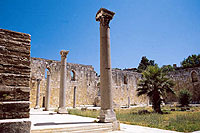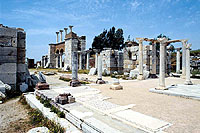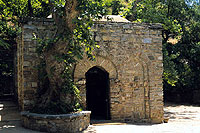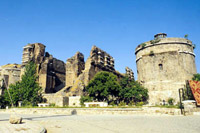İzmir
 İsa Bey Mosque ( İzmir-Selçuk): The mosque, which is on the Ayasuluk hill, at west slope of the St. Jean Bassilica, is a Seljukian piece of art. It was constructed in 1375 by Aydınoğlu İsa Bey.
İsa Bey Mosque ( İzmir-Selçuk): The mosque, which is on the Ayasuluk hill, at west slope of the St. Jean Bassilica, is a Seljukian piece of art. It was constructed in 1375 by Aydınoğlu İsa Bey.
Hisar Mosque (İzmir-Center): Built on the center of the Kemeraltı-Hisarönü square in 1592, the mosque was the biggset mosque in İzmir.It is among the monumental mosques having one storeies.It was built by hewn stones. Ahuge onein the middle, it was encircled with many small domes.Interior sections of the mosque reflects the most precious styles of Ottoman art.
Birgi (İzmir-Ödemiş): It is 9km from Ödemiş. Having the outstanding samples of Ottoman and Seljuk architecture, the city has been added to the list of World Heritage List. The structure includes İmam-ı Birgivi Tomb and Medresseh, Darül Hadis Medresseh, Güdük Minare Mescit( small mosque), Ulu Mosque and Aydınoğulları Tomb.

İzmir Church (Center): It is said that İzmir Church, which is the second one of the seven churches mentioned in Holy Bible, means "Followed" and "Be Faithful". The period, when İzmir Church was important, is II. and III. Centuries A. D. Ruins of this church are mentioned as at Çeşmelik district, at the sameplace with St. Polikarp church by some archeologists and Christian religious writers.
Karataş Beth Israel Synagogue: The synagogue, which is on Mithat Paşa Boulvard, is witnessing marriage ceremonies with its last century particular Victoria style architecture.
House of Virgin Mary (İzmir- Selçuk): It is thought to be constructed during IV. Century A. D. Of this place, also named as "Panaya Kapulu" by Christians on 420 meters high Mount Bülbül which is nine kilometers away from Selçuk. On the niche part, which remembers an oven, precious heart of Jesus Christ is represented. Such before the crucifixion, Jesus Christ entrusted his mother to his friend and disciples.As St. Jean thought that to stay in Jerusalem would be dangerous for Virgin Mary after the curicifixion of Jesus Christ, he took her here. Though these rumours are confused with legends, there are evidances proving that these have great deals to do with reality. Having undertaken a sacred mission as to spread Christianity, St. Jean chose Efes as the biggest city of the era, and secluded Virgiv Mary at a hut in a wood of trees very close together on the skirts Bülbül Mountain because he did not want Virgin Mary to live in a place where idol worshippers would annoyed her.
 Every day St. Jean secretly visited her and took to her food. It has been considered that Virgin Mary lived and died there when she was 101years old. Then St. Jean buried Virgin Mary again at this secret place which was unknown to anyone except himself. After Christinaity became world wide, a church with "Cross" like layout was constructed of this sacred place of Virgin Mary.
Every day St. Jean secretly visited her and took to her food. It has been considered that Virgin Mary lived and died there when she was 101years old. Then St. Jean buried Virgin Mary again at this secret place which was unknown to anyone except himself. After Christinaity became world wide, a church with "Cross" like layout was constructed of this sacred place of Virgin Mary.
This house is declared as the holy place of Christianity by Papacy in 1967. A ceremony is organized here during the first Sunday of following 15th of August, and people, who came here become hadji.
St. Jean Basilica (İzmir-Selçuk): Perched on Ayasuluk hill, it was constructed by Byzantium Emperor Justinien as a dedcation to St. Jean in VI A.D. In the middle of the basilica, under the dome and at the eastern side of the grave of St. Jean which is lower than the ground level, there are the places of the priests. These structures are separeted from the church with their half squares. At the northern section of the cemetery, monogra ms of the Emperor Justinien and his wife were perched on a restored pedestals of a church decorated with the frescos of the paintings of the saints.
ms of the Emperor Justinien and his wife were perched on a restored pedestals of a church decorated with the frescos of the paintings of the saints.
Bergama Church (İzmir-Bergama): It is among one of the seven churches mentioned in the Holy Bible and the location of which is known and the basilica known as "Red Courtyard"by the people of the Pergamum carries the meanings of "Serapien"( as it was devoted to the God Serapis) and "Where on earth or in heavens". After the death of Jesus Christ, it had a crucial postion in between the years 313-500.